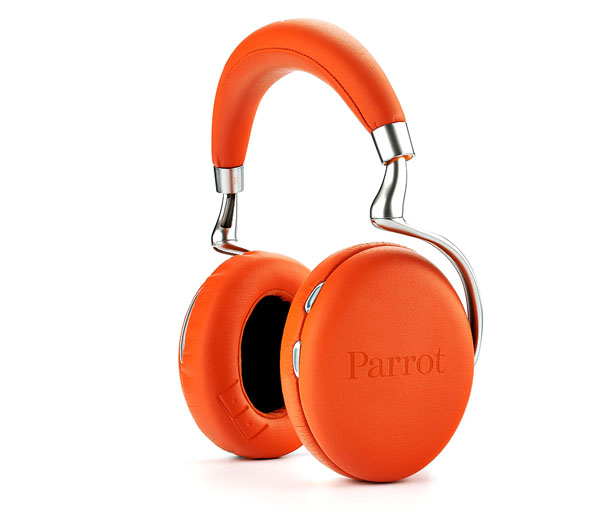| Columns Retired Columns & Blogs |
Bluetooth Headphone/Headset Survey Review - Parrot Zik 2.0

Parrot Zik 2.0 ($399)
Wow! This is an amazing headphone. It's got a few trouble spots, but it's also the most fully-featured BT headset one could buy.
The look is spectacular. The headband and ear capsules are covered in protein leather and are available in six colors (black, blue, orange, yellow, tan, and off-white). Headband arms are injection molded metal.
One power button is present, remaining controls (pause, play, track forward, phone answer, etc) are effected by swiping motions on the outside of the right ear capsule. Sensors in the right ear-pad detect when headphones are removed and automatically pause playback.
Comfort is good, but not great. Ear cups are a little shallow and close around the ear, and the headband touches only a small area on the top of the head which can lead to a little discomfort over time.
A companion app is available for both iOS and android platforms, and is pretty much mandatory for controlling the features on the Zik. The app gives access to: current battery charge state; noise cancelation on/off and amount; parametric equalizer; virtual speaker and room control; and the ability to save presets for the various functions.
Battery life when wireless and with all functions active is about seven hours, but can stretch out to 18 when wired.
On the down side, likely because of the sensors, the ear pads are not replaceable. And the carry case that come with the Zik 2.0 is a simple cloth bag. Really, for a headphone this expensive it should have a better case and replaceable pads. Also, it does not have aptX for Bluetooth connections.
The sound quality of the Zik 2.0 is much improved over the original Zik. They tout using a 32-bit DSP chip internally, and I think this may be responsible for the headphones sounding much less artificial sounding than the original. The virtual speaker function is quite effective, delivering useful spacial control of the sound. No, it won't get the sound out of your head, but it does do a nice job of getting rid of extreme left/right imaging of hard panned sound. The parametric equalizer is a real treat.
Listening with all sonic controls bypassed the overall sound quality is good and slightly warm sounding, though remains a bit breathy and artificial in the treble region. Bass extension is superb, and bass quality is quite good. Transitions into, through, and out of the mid-range are all quite good. The good news here is that the parametric EQ and virtual speaker controls give you pretty comprehensive control of the sonic character of the Zik 2.0.
Noise canceling is very effective and well behaved, providing -27dB broadband attenuation of outside noise.
All-in-all, I'd characterize the Zik 2.0 as a marked improvement over the original Zik with lighter weight, longer battery life, and better sound quality. I think there's room for improvement, however, with an aptX BT connection, replaceable ear pads, and a better carry case. I'll happily recommend them for those with a yen for sexy gadgets with the caveat to be careful with them as pad wear will limit the lifetime of the product.
Click on graphs image to download .pdf for closer inspection.
These measurements are with noise canceling active.
Uncompensated plots show the Zik 2.0 is unphased by positional changes on the ear but for inaudible changes below 20Hz. Compensated plots show a rising bass starting at about 120Hz to 15dB above baseline at 20Hz. I don't think I've heard a profile like that on a headphone before...and I kind of like it. The bass doesn't sound thick or overpowering, but is dramatic in it's reach in the lowest octave. Transition into and through the mids is good with a slight boost to the presence region between 1kHz and 3kHz.
The treble above 3kHz is a bit of a mess, and probably results in the artificial, breathy sound sometimes heard. It also may be possible that the virtual speaker DSP may have been on during measurements. (I set the headphone controls while paired to my smartphone, but have to decouple and pair to the BT transmitter in my test rig for measurements. I'm not sure if the last setting from the smartphone is actually retained when switching over.)
30Hz square wave has an odd humped shape due to the rising bass response, but clearly shows the bass is tight and not going out of phase—something that's very common with noise canceling headphones.
300Hz square wave is a mess, and reflects the treble unevenness of the FR plot. Fortunately, it doesn't sound nearly as bad as it look, and again, this may just be the virtual speaker DSP doing it's thing.
THD+noise plot is okay, remaining below 1% except for the bass at 100dBspl—it's likely bass may suffer a bit at loud levels.
Noise canceling is very good at -27dB broadband attenuation.
- Log in or register to post comments





































